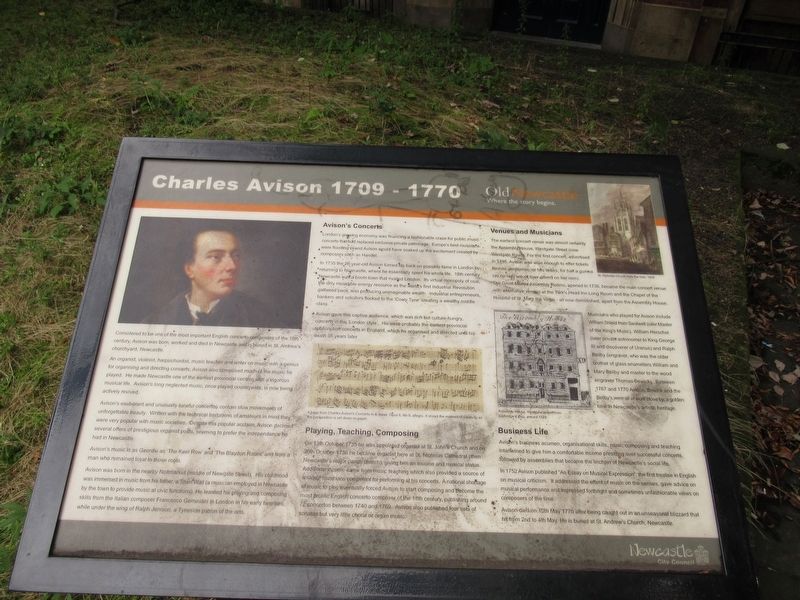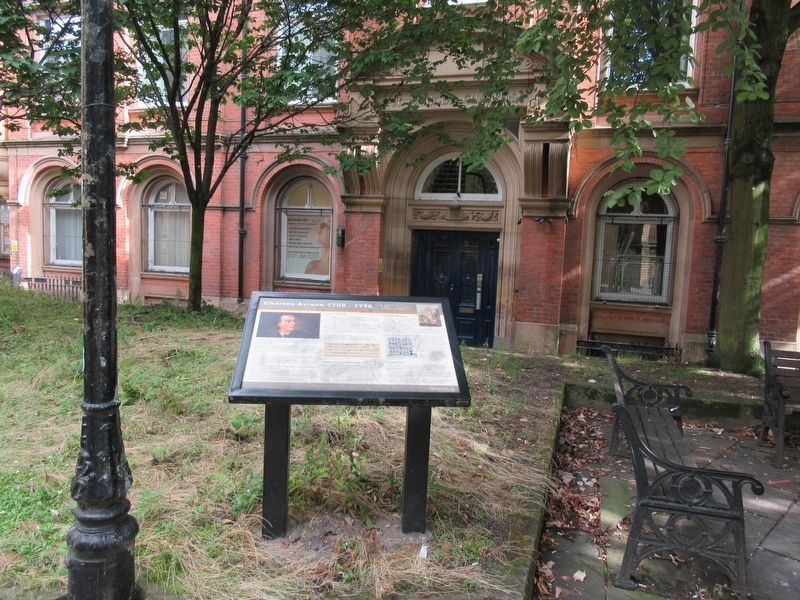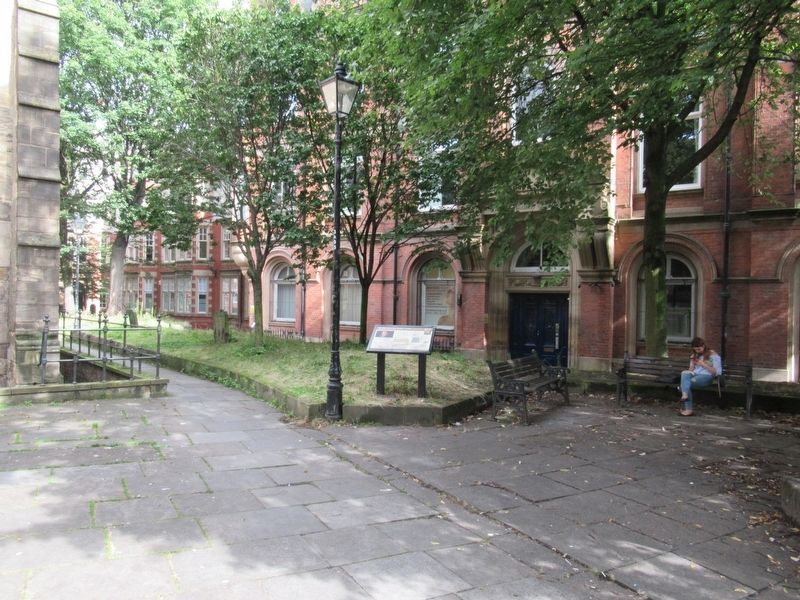Newcastle upon Tyne in Tyne and Wear, England, United Kingdom — Northwestern Europe (the British Isles)
Charles Avison
An organist, violinist, harpsichordist, music teacher and writer on music with a genius for organising and directing concerts, Avison also composed much of the music he played. He made Newcastle one of the earliest provincial centres with a vigorous musical life. Avison's long neglected music, once played countrywide, is now being actively revived.
Avison's exuberant and unusually tuneful concertos contain slow movements of unforgettable beauty. Written with the technical limitations of amateurs in mind they were very popular with music societies. Despite this popular acclaim. Avison declined several offers of prestigious organist posts, seeming to prefer the independence he had in Newcastle.
Avison's music is as Geordie as ‘The Keel Row’ and ‘The Blaydon Races’ and from a man who remained loyal to those roots.
Avison was born in the nearby Noltmarket (middle of Newgate Street). His childhood was immersed in music from his father, a Town Wait (a musician employed in Newcastle by the town to provide music at civic functions). He learned his playing and composing skills from the Italian composer Francesco Geminiani in London in his early twenties, while under the wing of Ralph Jenison, a Tyneside patron of the arts.
Avison's Concerts
London's growing economy was financing a fashionable craze for public music concerts that had replaced exclusive private patronage. Europe's best musicians were flooding in and Avison would have soaked up the excitement created by composers such as Handel.
In 1735 the 26 year-old Avison turned his back on possible fame in London by returning to Newcastle, where he essentially spent his whole life. 18th century Newcastle was a boom town that rivalled London. Its virtual monopoly of coal, the only moveable energy resource as the world's first Industrial Revolution gathered pace, was producing unimaginable wealth. Industrial entrepreneurs, bankers and solicitors flocked to the ‘Coaly Tyne’ creating a wealthy middle class.
Avison gave this captive audience, which was rich but culture-hungry, concerts in the ‘London style’. His were probably the earliest provincial subscription concerts in England, which he organised and directed until his death 35 years later.
Playing, Teaching, Composing
On 13th October 1735 be was appointed organist at St. John’s Church and on 20th October 1736 he became organist here at St Nicholas Cathedral (then Newcastle's major parish church), giving him an income and musical status. Additional income came from music teaching which also provided a source of amateur musicians competent for performing at his concerts. A national shortage of music to play eventually forced Avison to start composing and become the most prolific English concerto composer of the 18th century, publishing around 72 concertos between 1740 and 1769. Avison also published four sets of sonatas but very little choral or organ music.
Venues and Musicians
The earliest concert venue was almost certainly the Assembly House, Westgate Street (now ·Westgate Road). For the first concert, advertised in 1735, Avison was wise enough to offer tickets for one gentleman or two ladies, for half a guinea (as no lady would ever attend on her own). The Groat Market Assembly Rooms, opened in 1736, became the main concert venue with alternative venues at the Turk's Head Inn Long Room and the Chapel of the Hospital of St. Mary the Virgin – all now demolished, apart from the Assembly House.
Musicians who played for Avison include William Shield from Swalwell (later Master of the King's Music). William Herschel (later private astronomer to King George Ill and discoverer of Uranus) and Ralph Beilby (engraver, who was the older brother of glass enamellers William and Mary Beilby and master to the wood engraver Thomas Bewick). Between 1767 and 1770 Avison, Bewick and the Beilby’s were all at work close by, a golden time in Newcastle's artistic heritage.
Business Life
Avison's business acumen, organisational skills, music composing and teaching intertwined to give him a comfortable income presiding over successful concerts, followed by assemblies that became the linchpin of Newcastle's social life. In 1752 Avison published 'An Essay on Musical Expression’: the first treatise in English on musical criticism. It addressed the effect of music on the senses, gave advice on musical performance and expressed forthright and sometimes unfashionable views on composers of the time.
Avison died on 10th May 1770 after being caught out in an unseasonal blizzard that hit from 2nd to 4th May. He is buried at St. Andrew's Church, Newcastle.
( photo captions )
A page from Charles Avison's Concerto in E minor, Opus 6, No 8, allegro. It shows the moment of creativity as the composition is set down on paper.
St. Nicholas Church from the side, 1808
Assembly House, Westgate Street, from Corbridge's map, around 1723
Topics. This historical marker is listed in this topic list: Arts, Letters, Music. A significant historical date for this entry is May 10, 1770.
Location. 54° 58.189′ N, 1° 36.68′ W. Marker is in Newcastle upon Tyne, England, in Tyne and Wear. Marker is at the intersection of St. Nicholas Street and Side, on the right when traveling north on St. Nicholas Street. Touch for map. Marker is in this post office area: Newcastle upon Tyne, England NE1 1PE, United Kingdom. Touch for directions.
Other nearby markers. At least 8 other markers are within walking distance of this marker. Admiral Lord Collingwood (within shouting distance of this marker); Victoria R I (within shouting distance of this marker); St. Nicholas Cathedral (within shouting distance of this marker); Cathedral Church of St. Nicholas (within shouting distance of this marker); Turning Bridge (within shouting distance of this marker); The Black Gate (within shouting distance of this marker); a different marker also named The Black Gate (within shouting distance of this marker); The Barbican (within shouting distance of this marker). Touch for a list and map of all markers in Newcastle upon Tyne.
Also see . . .
1. Charles Avison on Wikipedia. (Submitted on November 23, 2018, by Michael Herrick of Southbury, Connecticut.)
2. The Avison Ensemble. (Submitted on November 23, 2018, by Michael Herrick of Southbury, Connecticut.)
Credits. This page was last revised on January 27, 2022. It was originally submitted on November 23, 2018, by Michael Herrick of Southbury, Connecticut. This page has been viewed 179 times since then and 9 times this year. Photos: 1, 2, 3. submitted on November 23, 2018, by Michael Herrick of Southbury, Connecticut.


